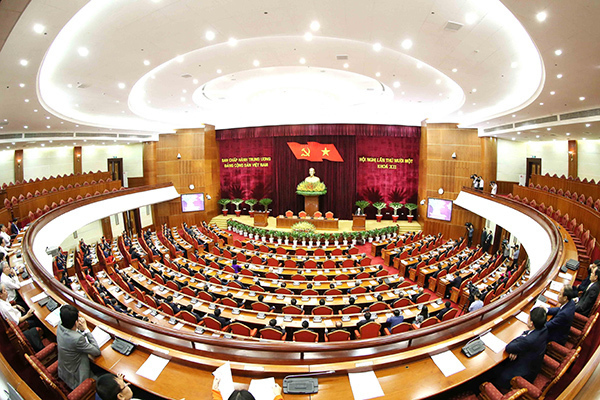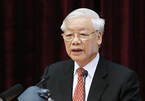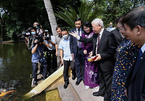Many enthusiastic responses have been introduced to raise awareness of the opinions in the article and contribute to the completion of solutions and measures to properly conduct the 13th National Party Congress, bringing the country into a new stage of development. VietNamNet introduces an article by Dr. Nguyen Manh Hung, from the Ho Chi Minh National Academy of Politics.
 |
|
|
To become a developed country
In the middle of the twenty-first century, to strive to turn our country into a socialist-oriented developed country. As the article stated, this clearly shows inheritance and development, continuity and completeness in the process of building socialism in our country.
Looking back, we know that the 8th National Party Congress documents defined the target by 2020, striving to turn our country basically become an industrial country. Documents of the 9th, 10th and 11th National Party Congresses continue to affirm: create a foundation for our country to basically become a modern industrial country by 2020. This target is also set out in the socio-economic development strategy for the period 2001-2010.
The upcoming National Party Congress needs to have a vision to the middle of the 21st century
The national construction platform in the period of transition to socialism (revised in 2011) also determines: by the middle of the 21st century, to strive to build our country into a socialist-oriented modern industrial nation. Documents of the 12th National Party Congress reiterates this goal in a new period but does not specify a specific time as before, as follows: striving to soon turn our country basically into a modern industrial country.
Obviously, from the 8th to the 12th Party Congress, the goal of becoming an industrial country has been determined relatively consistently, but the actual implementation has encountered a number of problems in both theory and practice:
First, the determination of the goal of "basically becoming an industrial country" (8th Party Congress) or later being adjusted to "basically becoming an industrial country in the modern direction" (9th, 10th, 11th and 12th Party Congress) is cautious but it is unclear and cannot be quantified, especially for the concepts "basically" and "in the modern direction". Some many studies tried to clarify these concepts, especially to quantify the set goals, but they have not reached an agreement.
According to the national development target, from the 8th Party Congress, many localities also set the target to become an industrial province or a modern industrial province. This leads to widespread industrial development, even in localities that do not have advantages to develop this field. Consequently, the economic structure is distorted, natural resources are exhausted and the environment is devastated.
Documents of the 12th Party Congress and the 30-year summary report on the Doi Moi (renovation) said: Creating the foundation to basically become a modern-oriented industrial country did not achieve the set target.
 |
|
Party Secretary General and President Nguyen Phu Trong. |
Second, in reality, the understanding of an "industrial country" is often relatively simple, even superficial, only paying much attention and emphasizing on economic structure instead of issues such as social development, technology level, environmental protection, human development ... In order to avoid simple understanding of "industrial country" (in the sense of focusing only on increasing the proportion of industry in the economic structure, leading to masses industrial development, including outdated industries), we introduced the term "modern-oriented industrial country" and proceeded to become "modern industrial country". These are also unique terms of Vietnam, not based on the world's classification.
However, in the context of rapid progress in science and technology, especially under the impact of the Fourth Industrial Revolution, many new economic models have emerged, such as knowledge-based economy, circular economy, sharing economy, weightless economy... which are completely different from the traditional economic model, with very new features, especially the blurring of boundaries between the agriculture, industry and service sectors. The countries in the world have no longer approached the target of becoming an industrial country for a long time.
With the spirit of maximizing democracy and listening to the people, the draft documents submitted to the 13th Party Congress proposed two options for defining the goals: Option 1: Vietnam will become a developed, high-income country; Option 2: Vietnam will become a modern industrial country with high income. Many opinions of delegates, officials, party members, experts, scientists ... presented at grassroots and higher-level Party Congresses all agreed that the goal should be set: Vietnam becomes a developed country.
In accordance with the times
There are many ways to group countries based on different criteria. Each international organization has its own way of grouping countries according to its purpose and they have adjusted the grouping method towards simplicity, easy to understand and make comparison. However, we would like to reiterate that in the world today the term "industrial country" does not have much practical meaning for setting development goals or policy directions.
Even the United Nations Industrial Development Organization (UNIDO) is now paying more attention to the modes and objectives of industrialization. In the Lima Declaration in December 2013, UNIDO set out the goal of developing sustainable and inclusive industry. UNIDO emphasizes the ninth goal of the Sustainable Development Goals (SDGs) on: promoting inclusive and sustainable industrialization, and encouraging innovation.
The UNIDO Industrial Development Report uses the terms "industry" and "development" in grouping economies, including: i) industrialized economies; ii) newly emerging industrial economies; iii) other developing economies; and iv) least developed economies. Vietnam is classified in the group: "other developing economies" in the Asia and Pacific region.
International organizations such as International Monetary Fund (IMF), World Bank (WB), Organisation for Economic Co-operation and Development (OECD), World Trade Organization (WTO), United Nations (UN) etc. use the method of grouping countries and economies by level of development or more specifically the per capita income, with the two quite common groups: i) 'developing' countries (i.e. low-income and middle-income countries); and ii) “developed” countries (ie high-income countries).
This classification has been used by many international organizations and countries to define the terms of aid (such as: identifying grants or loans; determining interest rates and fees), preferential regimes when joining free trade agreements, rights and obligations to participate in cooperation programs, etc. The OECD's Development Assistance Committee distinguishes between two groups of countries: "developed countries" and "developing countries", in which developing countries can receive official development assistance. After moving from the group of low-income countries to middle-income countries, a country will also be subject to review of aid terms by international organizations and developed countries, especially non-refundable aid.
In the United Nations statistical system, although there is no official regulation, since 1996, the classification of member countries into developed and developing countries has been applied, mainly for statistical purposes but not for an official assessment of a country's level of development.
However, this classification has increasingly become formal, as it has been used in assessing the implementation of the Millennium Development Goals (MDGs) and the Sustainable Development Goals (SDGs). Based on the Human Development Index (HDI), the United Nations Development Program (UNDP) identifies developed countries as those in the top 25% of the HDI; Developing countries are among the remaining 75%.
The IMF classifies economies into two groups: i) advanced economies (actually developed economies); and ii) developing economies and newly emerging markets. This classification is based on the main criteria, including: i) income per capita; ii) export diversification (oil exporting countries are not counted as advanced economies since oil accounts for more than 70% of their export value); iii) the degree of integration into the global financial system.
However, these are not the only criteria for ranking economies. The goal of the IMF is to present a method to organize and classify data accordingly. IMF also made adjustments when the above indexes had major changes. For example, when Lithuania joined the Eurozone, the IMF moved the country from the group of newly emerging economies to the group of developed economies.
Dr. Nguyen Manh Hung (Ho Chi Minh National Academy of Politics)

Prepare and organize the National Party Congress well, bring the country into a new stage of development
VietNamNet would like to introduce an article by Party General Secretary and President Nguyen Phu Trong, entitled “Prepare and organize the National Party Congress well, bring the country into a new stage of development".

The people and the ruling party's measure of value
"In all works of the Party and State, the people are always defined as the root," Party Chief and President Nguyen Phu Trong wrote in his article about the work that needs to be done for the 13th National Party Congress.